Tribute to Lex Barker
Preface: This page was really difficult to translate so
maybe something is wrong or I didn't use the right expressions. I
apologize in advance and ask for corrections!
As it took some time for me to get along with different information about aspect ratio on DVDs I assume that others may have the same problems. So I try to explain some common formats on this page but I want to make clear that I may be wrong or too simplifying so I apologize in advance for being to smattering and I'd appreciate any correction. This matter is much too complicated to explain it on this short page so if anyone wants to learn more about picture formats and proportions should search the net, for example Bibra-Online.de (German language only).
The common TV screen has a aspect ratio of 4:3 which means it is for example 24 inches wide and 18 inches high. Since a while there have been TV screens with an aspect ratio of 16:9 which is closer to the common format of cinema films. The screen is wider than the usual TV screen, for example 32 inches wide and 18 inches high.
1. Made-for-TV movies are usually shot in 4:3 format which looks like this and is unexceptionable:

The picture matches exactly the TV format.
2. However many movies shot for the cinema have a wider aspect ratio. When you see such a movie unmodified on TV there will be the well-known black beams above and below the picture:

The film has the complete width of the cinema format but to match the TV
screen there are those black beams inserted everybody has seen
sometimes.
3. If the movie has been modified for TV by simply cutting off the picture on the right and the left side this is the most annoying possibility and often leads to hearing people speak who are outside of the picture or that the elaborate composition the director had in mind is gone. Therefore they often try to save the effect of the picture by matching the stripped section to the story line as good as possible. This proceeding is called "Pan & Scan" and looks like that:

This is rather unsatisfying!
4. Now there are TVs with an aspect ratio of 16:9 meaning the picture is wider than usual. A movie (or TV show, series, news and so on) shot in 4:3 will look like that here:

5. A cinema movie in 16:9 format will match this TV perfectly:

This is still pretty simple. Now we'll come to something more
complicated:
6. Some movies on DVD are saved in a special way so the picture will be completely shown on a common 4:3 TV. A movie shot in 16:9 format or wider will have the usual black beams (this method is called "letterbox"), see No. 2. That's self-evident. If you watch such a movie optimized for 4:3 on a 16:9 TV it will first look like that:

6a. This is a bit smaller than the TV could show such a
movie and therefore those TVs are able to zoom it in so it will match
the screen completely again:

6b. This looks a lot better, but unfortunately now
some quality is lost because by zooming the picture in it became more
blurred.
Therefore there are some more possibilities to optimize cinema format movies for TV:
7. The picture can be laterally skewed so it will look like that on a 4:3 TV:
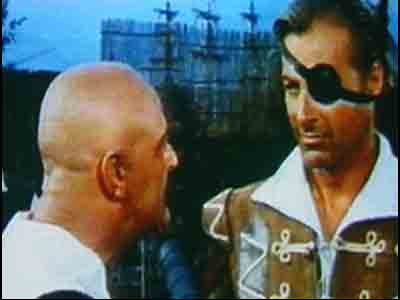
7a. This looks pretty silly! Older TVs can show the
picture just this way, newer 4:3 TVs can equalize it so it will be shown
in the correct ratio with the well-known black beams.
7b. A 16:9 TV can equalize it so it will now match the screen perfectly, just like 6b, but this time without any loss of quality, so it will be a bit more clear.
8. The 16:9 format is maintained. Now you will see the complete picture on a 16:9 TV with full quality. The picture will be a bit better than a zoomed in movie, just like No. 7b.
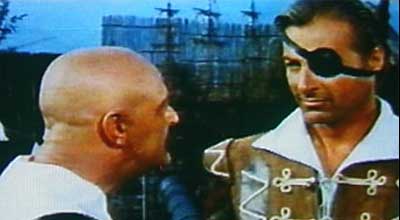
According to its possibilities or the user's wishes a 4:3 TV can cut off the picture on both sides (now of course without possibilities to match the story line) or the movie will be shown completely, again with black beams. Maybe the picture will look like that now:

This is awful!
Or maybe as shown above:

This is ok.
This is just an approximate description of the different information on a DVD. Strictly speaking it would be important to know the exact kind of the picture's compression method (for example anamorph* or some different kinds) and the possibilities of the TV. So don't take these explanations and examples in literal sense. If I am completely wrong about something - please mail to !
To know the right format when bying a DVD it is - or should be - mentioned on it whether it is optimized for 4:3 or 16:9 TV. Sometimes this information can be mistaken because it reads "4:3" or "16:9". This means nothing about the original film format! To know about the film format you need an additional information like "Widescreen", "Cinemascope", "2,35:1", "16:9" and so on. But unfortunately there are DVDs with hardly or literally any information (see below).
Example: On the DVDs by Kinowelt (Winnetou 1 to 3, Treasure of Silver Lake) you find the following information:
Bildformat: 16:9 Widescreen 1:2,35
This means the movie is optimized for 16:9 TVs and the original format is 2,35:1 which is wider than 16:9 so there will be wide black beams on a 4:3 TV. Unfortunately not all DVD producers signify their DVDs so clearly. On a very old 4:3 TV you will see the movie skewed, with a newer one with wide black beams. On a 16:9 TV you will have narrow black beams because the movie is even wider than 16:9.
To completely confuse you now I made a table with the most common movie and TV formats, quite surely this is not a complete list!
| Name | Ratio width to height | Corresponds with: | To be seen on TV: |
|---|---|---|---|
TV formats |
|||
| Common TV 4:3 | 1,33:1 | Exactly 4:3 | |
| Widescreen TV 16:9 | 1,78:1 | Exactly 16:9 | |
Cinema formats |
|||
| Academic Format (oldest format) | 1,37:1 | A small bit wider than 4:3 | Very small black beams above and below the picture which can hardly be noticed. |
| Widescreen (since about 1953) | 1,85:1 | A bit wider than 16:9 | Wider than usual TV format, therefore the well-known black beams above and below the picture. A bit wider than 16:9 TV format, so narrow black beams will be seen here, too. |
| Cinemascope (since about 1953) | 2,35:1 up to 2,55:1 | obviously wider than 16:9 | A lot wider than 4:3, therefore very broad black beams above and below. It's wider than 16:9, so you will see black beams here, too. |
| Panavision | 2,40:1 | obviously wider than 16:9 | Corresponds to Cinemascope |
| Cinerama | 2,65:1 | extremly wide, a lot wider than 16:9 | Corresponds to Cinemascope, but even wider. |
| Ultra-Panavision | 2,76:1 | extremly wide, a lot wider than 16:9 | Like the above, 4:3 TVs will show a very small picture. |
To illustrate this whole thing I made a table - I love tables - with a direct comparison how the movies look like on different TVs - please don't compare each inch or the quality, but it should give you an impression of the different possibilities.
| Format on DVD | 4:3 TV | 16:9 TV |
|---|---|---|
Orignal format 4:3 "Battles of Chief Pontiac" |
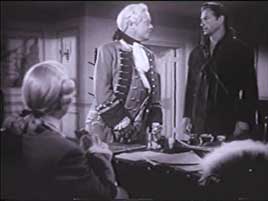 Full screen, quality unchanged |
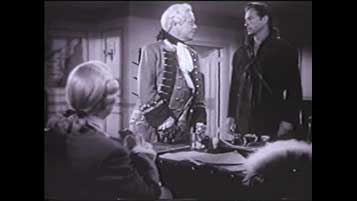 Black beams on the right and the left, quality unchanged |
Original format 16:9 Optimized for 4:3 "I Pirati della Costa" |
 Black beams above and below the picture |
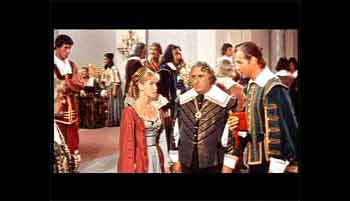 This movie is optimized for 4:3, so it is smaller than the screen. Can be zoomed to full screen but looses some quality. |
Original format 16:9 or 2,35:1 Optimized for 16:9 Example for 2,35:1 is "Winnetou 2 (Last of the Renegades)" |
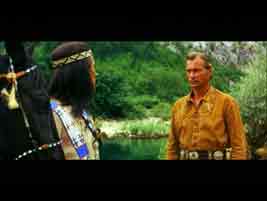 16:9 movies: black beams above and below. 2,35:1: wide black beams on top and bottom. Maybe skewed or cut off according to TV (on very old TVs only) |
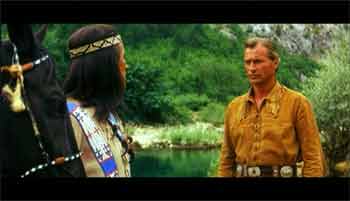 Full screen without zooming for 16:9 movies, just as described in No. 8. Best possible quality. For 2,35:1 movies: there are still narrow black beams. |
My DVDs with Lex-Barker movies have the following properties:
| Film | Information on DVD | Real format |
|---|---|---|
| Wenn du bei mir bist | 4:3 | 16:9, optimized for 4:3 (see example) |
| Aoom El Genio Tranquilo |
No information given No information given |
16:9 16:9 |
| Winnetou und Shatterhand im Tal der Toten - Universum Shatterhand-Box - |
2,35:1 (16:9 anamorph* codiert) | 2,35:1, optimized for 16:9 (see example) |
| Winnetou und Shatterhand im Tal der Toten - Kinowelt Edition - |
1,66:1 | A bit narrower than 16:9, optimized for 4:3 (see example) |
| The Castle of the Walking Dead | Widescreen 1,66:1 (anamorph*) | A bit narrower than 16:9, optimized for 4:3 (see example) |
| Woman Times Seven | 1,66:1 | Between 4:3 and 16:9, optimized for 4:3 (see example) |
| Le Carnaval des Barbouzes | No information given | A bit more narrwo than 16:9, optimized for 4:3 (see example) |
| Wer kennt Jonny R.? A Place called Glory - Lex-Barker-Box by Universum-Film - |
1,85:1 (4:3) 1,78:1 (4:3) |
both movies: 16:9, optimized for 4:3 (see example) |
| Im Reich des silbernen Löwen - Orient-Box by Universum-Film - |
2,0:1 (4:3 letterboxed) | Narrower than 2,35:1, but wider than 16:9, optimized for 4:3 (see example) |
| Pyramid of the Sun God Treasure of the Aztecs |
2,35:1 (16:9 encoded anamorph*) | 2,35:1, optimized for 16:9 (see example) |
| Der Schut Durchs wilde Kurdistan - Orient-Box by Universum-Film - |
2,35:1 (16:9 encoded anamorph*) | 2,35:1, optimized for 16:9 (see example) |
| Code 7, Victim 5 / Table Bay - NTSC version english - |
No information given | 4:3 (see example) |
| Old Shatterhand - Universum Shatterhand-Box - |
2,35:1, (16:9 anamorph* codiert) | 2,35:1, optimized for 16:9 (see example) |
| Old Shatterhand - Kinowelt Edition - |
16:9 (2,20:1) | 2,20:1, optimized for 16:9 (see example) |
| Treasure of Silver Lake Half Breed Apache Gold Last of the Renegades - Karl-May-Boxes DVD-Collection I and III by Universum-Film - |
16:9 Widescreen 1:2,35 | 2,35:1, optimized for 16:9 (see example) |
| Apache Gold Last of the Renegades The Desperado Trail Treasure of Silver Lake - Kinowelt-Editions - |
16:9 Widescreen 1:2,35 | 2,35:1, optimized for 16:9 (see example) |
| Il Boia di Venezia | 4:3 | 16:9, optimized for 4:3 (see example) (according to imdb the original film format is 2,35:1). This movie must have been cut off to 16:9 format for TV. (see 3.). |
| Im Stahlnetz des Dr. Mabuse | 1:1,66 | 1,66:1 (a bit narrower than 16:9), optimized for 4:3 (see example) |
| Il Segreto dello Sparviero Nero | 4:3 (1:2,35) | 2,35:1, optimized for 4:3 (see example) |
| Robin Hood e i Pirati | 1:1,85 (16:9 anamorph) | 16:9, optimized for 16:9 (see example) |
| I Pirati della Costa | Widescreen | 16:9, optimized for 4:3 (see example) |
| Il Cavaliere dei Cento Volti | WS 1,78:1 anamorph | 16:9, optimized for 16:9 (see example) |
| El Secreto de los Hombres Azules | Full screen 4:3 | 4:3 (see example) |
| La Scimitarra del Saraceno | 4:3 | 16:9, optimized for 4:3 (see example) |
| Away All Boats | 1,33:1 (4:3) | 4:3 (see example) |
| Battles of Chief Pontiac | No information given | 4:3 (see example) |
| Crossfire | 1,33:1 (4:3 Full screen) | 4:3 (see example) |
| Unconquered | 4:3 | 4:3 (see example) |
| Doll Face | keine Angabe | 4:3 (see example) |
* = encoded "anamorph" means that the movie has been skewed with a special lens while shooting. These movies are equalized in the cinema by using congruous lenses. Most TVs can equalize these pictures, too.
You can see that information on DVDs differ widely. Sometimes you will be able to see what you bought only by watching it on TV.
![]() Back to Videos and
DVDs
Back to Videos and
DVDs
| back to normal view | Last edited on: 13.02.2011 | |
| https://www.tribute-to-lex-barker.net | ||